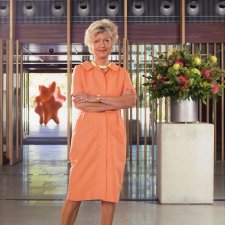William Robinson AO (b. 1936) is one of Australia's most distinguished and influential contemporary painters, known for his distinctive and prolific output as landscape painter in particular. Born and raised in Brisbane, he trained as a teacher and studied art at the Central Technical College (now Queensland University of Technology) in the 1950s, after which he began a distinguished career as a tertiary art educator in Brisbane and Toowoomba (including at QUT). His painting practice continued alongside his teaching work, and he held his first solo exhibitions in Brisbane in the late 1960s. During the 1970s, following his move with his wife Shirley to a small farm outside Brisbane, he began creating works which were inspired by Bonnard and documented his surroundings, the interiors of his home and the day-to-day life of his growing family. When they moved to a bigger property at Beechmont in the Gold Coast hinterland, he began painting farmyard scenes – witty, merry pictures in which cows, goats, chickens and other animals cavort across the picture plane, often with minimal acknowledgement of realism or perspective. He included self portraits and portraits of Shirley in many of these works. 'Every place that we've ever lived has really affected my work', Robinson has stated. 'My work is a total reflection of my life, and these places have sometimes been difficult but they have been of extreme importance because they have given me an individuality … rather than a recipe which must be followed, or fashion or anything like that. I abhor fashion: I could never become a fashion model and nor could I become a fashionable painter, because I just do what I am.' The move to Beechmont also initiated Robinson's engagement with the landscape, which he likewise began rendering in swirling, increasingly Romantic compositions that dispense with conventional viewpoints, incorporating multiple perspectives instead. Skies, rivers, rainforests and ranges contort and are upended; night and day, summer and winter coincide; trees grow sideways or upside-down; stars collide with the forest canopy and vice-versa. During the same period, Robinson entered the Archibald Prize for the first time with William and Josephine (1984) – a self-portrait with one of his favourite cows. Robinson won the Prize for the first time in 1987 with Equestrian self portrait; his second Archibald win came in 1995 with Self portrait with stunned mullet – his final Archibald entry.
Art critic John McDonald has written that Robinson 'is the only non-Aboriginal artist since Fred Williams and John Olsen to give us an entirely new view of the Australian landscape.' Twice winner of the Wynne Prize (in 1990 and 1996), Robinson's name has become synonymous with swooping, grand and all-encompassing pictures of gnarled rainforests and deep green mountain ranges, dizzying views of the heavens, and paintings evoking the creation. His work is represented in in each of the major Australian public art museums as well as in prestigious international collections such as those of the Metropolitan Museum of Art, New York, and the British Museum, London. In 2011, Robinson donated works valued at almost $5 million to the Queensland University of Technology in honour of his longstanding association with the institution as a student and educator. The gift included both of his Archibald-winning self portraits and now forms the basis of the William Robinson Gallery, situated on QUT's Gardens Point campus in Old Government House. Robinson has held numerous solo exhibitions since the late 1960s and his work has been included in a similar number of prestigious group exhibitions. He has represented Australia at the Venice Biennale (in 1990), and the retrospectives of his work – William Robinson: the revelation of landscape (SH Ervin Gallery, Sydney, 2003) and Darkness and Light: the art of William Robinson (QAG, 2001) have toured to venues across the country. Robinson's official honours include an AO, awarded in 2007, and three honorary doctorates.
Gift of Patrick Corrigan AM 2004. Donated through the Australian Government's Cultural Gifts Program.
© Gregory Weight/Copyright Agency, 2024
Patrick Corrigan AM (130 portraits)



On one level The Companion talks about the most famous and frontline Australians, but on another it tells us about ourselves.



Greg Weight on working with Jiawei Shen, and starting out as a photographer.



Portraits of philanthropists in the collection honour their contributions to Australia and acknowledge their support of the National Portrait Gallery.